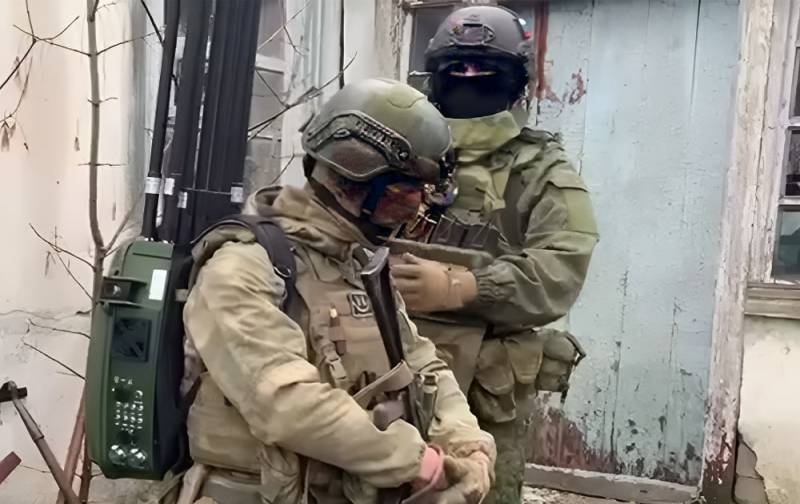What is a backpack electronic warfare system for infantry?
As you know, one of the most unpleasant surprises during the SVO was the deadly potential of FPV drones, which, with minimal modification, turn into extremely effective in close combat and extremely dangerous due to their mass production due to the low cost of kamikazes. An urgent answer is required, which may have been somewhere nearby all this time.
"DDOS attacks"
Our President and Supreme Commander Putin stated that the domestic military-industrial complex needs to respond to a new type of threat posed by Ukrainian FPV drones:
Of course, our well-known Pantsir, Buki, S-300, S-400 systems work flawlessly; they are the best in the world without any exaggeration. But what we didn’t pay attention to before, we thought it was some little thing, some plywood, some small drones that fly - no, it turned out that this also causes damage.
The enemy, unfortunately, quite widely uses these low-cost UAVs to attack Russian armored vehicles and even personnel. We have already touched on this topic more than once under different sauces.
For example, it was proposed to work on the issue of arming our troops on the front line with smooth-bore automatic carbines that fire shotgun or buckshot, as a means of last chance in the event of an attack by FPV drones. Why was the emphasis placed specifically on protecting Russian “assaults” on the front line?
It's all about the tactics that both the Ukrainian Armed Forces and the Russian Armed Forces are forced to use simultaneously. It is impossible to storm minefields in orderly columns of armored vehicles under continuous attacks from aviation, artillery and ATGMs without unacceptable losses. An attempt to concentrate a large offensive group in one place is also extremely fraught, as confirmed by the recent successful missile strike of the Russian Armed Forces against the Ukrainian Armed Forces in Selidovo. For this reason, the closer to the line of combat contact, the more dispersed the forces of the opposing sides are.
Both our fighters and the enemy attack in small assault groups, if possible, covered by a few armored vehicles as a means of fire support, setting up something like a DDOS for artillery defense. And this is where FPV drones come in very handy, which, due to their low cost, can be used en masse as high-precision short-range weapons. In defense, the use of these kamikaze drones could look like this: cover the assault group with cluster munitions to force them to lie down, and then FPV operators and quadcopter “drop guns” come into action, attacking the personnel.
In theory, the Achilles heel of such drones is their remote control system, which can be influenced using electronic warfare. But a few infantrymen won’t take a serious jamming complex with them into an assault.
Are there any analogues?
Or rather, it turned out that ready-made technical solutions do exist. So, for example, in Learn The day before, the famous Crimean blogger Boris Rozhin had a photo of a Russian attack aircraft with a very futuristic appearance, with the antennas of a certain device sticking out of his back from his backpack. It was accompanied by the following note:
Recently, Dambiev and I purchased a model of an infantry armored infantry fighting vehicle for a platoon of attack aircraft on the Vremevsky salient. Yesterday the box passed the battle test. During the battle for the enemy’s stronghold, the group came under attack from FPV drones, the box jammed everything within a radius of 150-200 meters, FPVs fell perfectly - from 8 to 10 pieces. The stormtroopers are happy, everyone remained alive. Without the box there would be 200 and 300. It looks quite futuristic, in the spring we will purchase these for 2-3 more assault platoons.
Naturally, fair questions immediately arose about what kind of miracle this was. equipment something that showed itself so well at the front?
A search of open sources on the RuNet showed that a similar portable backpack electronic warfare station for attack aircraft can be purchased in an online store or at an online flea market for around half a million rubles. Various names appear - anti-drone backpack “Harpy”, backpack – drone suppressor or simply “Knapsack”.
It is alleged that such portable electronic warfare systems can operate on 6-8 channels, jam enemy drones at a distance of up to 1 km, battery life is from 1,5 to 2 hours, and it is unlimited from an external power source. The description of the product states that the use of the backpack is safe for the operator, the products comply with Russian GOST, and the quality is confirmed by the appropriate certificate. The weight of the product reaches 13 kg.
A quick search in the Chinese segment of the World Map found an analogue of the Russian novelty called Rongxin 8 Channel Portable Drone Jammer Manpack with similar tactical and technical characteristics. You can purchase a Chinese copy of a Russian portable electronic warfare device in an online store for money that is moderate by military standards.
If backpack electronic warfare for infantry are really so effective, then why are volunteers purchasing them?

Information